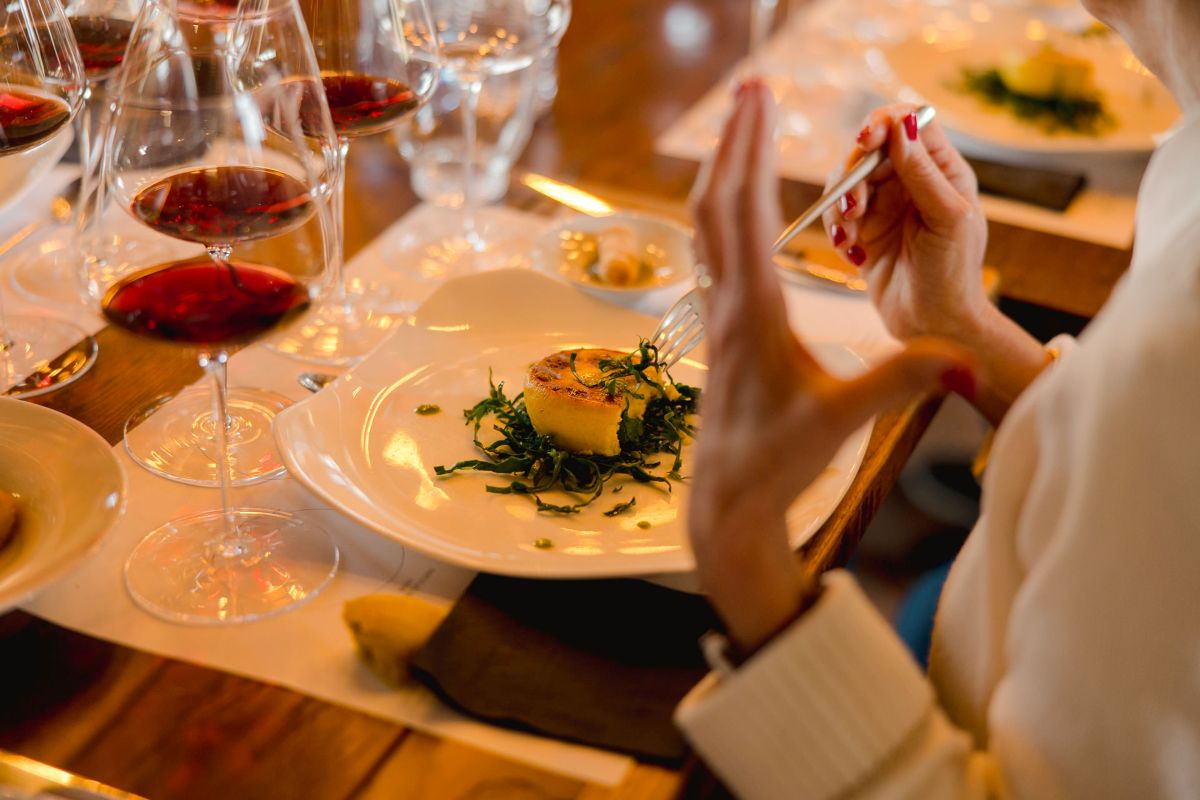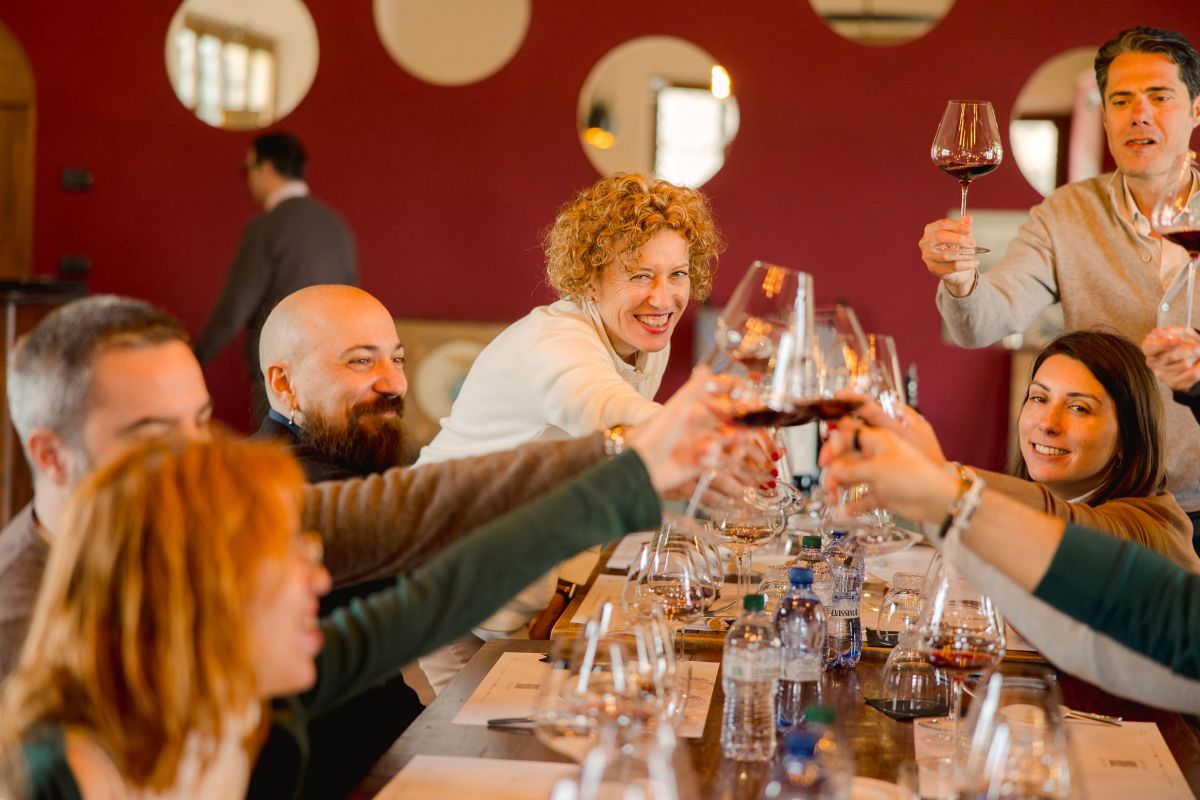Last Updated on November 22, 2025 by Emma Fajcz | Published: February 16, 2022
Sure, the Renaissance brought Tuscany quite a bit of fame—but nothing has continued to capture hearts quite like a glass of Tuscan wine.
You can’t miss a trip to Florence without a sip, and chances are when you head home you’ll be wanting to fill your suitcases with the amazing (and affordable) vini di Toscana. But the options are endless at the enoteca, and it can all seem a bit overwhelming. Where do you even begin?
No worries, we’ve got you covered with this guide to Tuscan wines.

Overview of Tuscan wine
Tuscany is arguably one of Italy’s most internationally recognized wine regions. From Chianti to Brunello, who hasn’t heard of at least one Tuscan wine?
While you might see Tuscan wine seemingly everywhere you go in Italy, the region actually only makes up 6 percent of the country’s whole wine production. Tuscany produces 90 percent red wine, and that red wine is primarily made with the key grape of Tuscany, sangiovese. Though many of the wines of Tuscany are made with the same primary grapes, they have quite different tastes due to the changing soils, and climates.
Sangiovese is 61 percent of vineyard production, after which there is Merlot, making up 8 percent, and Cabernet Sauvignon at 6 percent. Here you’ll come across 11 DOCGs and 41 DOC appellations, or wine regions. These appellations make up the majority of production, while IGT makes up about a third of production.

DOCG, DOC, IGT: Italian wine appellations
Of course, before we get really into the ins and outs of Tuscan wine, it’s good to understand a little more about how Italian wines are judged and categorized. This will help you read Italian wine labels wherever you find them.
DOCG, DOC, and IGT all refer to different appellations—wine regions within the area that follow set rules to produce quality wines typical of the area.
- DOCG (Denominazione di Origine Controllata e Garantita) is the top tier in terms of quality control. These wines follow strict production methods and must undergo a taste test as well as a lab test in order to ensure that what you get in the bottle is of the best possible quality. The strict rules include alcohol percentage, how many bottles can be made, and how many grapes can be harvested for the production.
- DOC (Denominazione di Origine Controllata) is just one step under DOCG. These wines still have strict rules with regards to vine density, harvesting, and production, but they do not need to undergo the tough tests. This is where most wine you’ll drink in Italy is found.
- IGT (Indicazione Geografica Tipica) is the lowest of the quality checks. It still has rules, but they are more flexible. While this means they aren’t necessarily monitored, it definitely doesn’t mean it is bad wine. In fact, this is where some of the most interesting wines are found—especially in Tuscany.
Each of Tuscany’s different DOCG and DOC wines represents a different region, but it doesn’t stop there. Some of them even have subzones. For example, Chianti DOCG actually has 7 different subzones, which each produce unique wines—more on that below.

Tuscan wine history
Wine has been around in Tuscany for centuries. The Etruscans were the first to start growing vines in the area, way back in the 9th century BCE. If you wander outside of Florence, you’re bound to come face to face with some Etruscan artifacts, tombs, and ancient remnants:
- For the Etruscans, wine was more than just a drink to enjoy, it was an entire way of life—an essential element to their culture, society, and daily routines. With their wine, they formed strong trade routes that actually helped strengthen relations throughout all of Italy and abroad. Tuscany was even exporting its wines to Spain and France way back in the 7th century BCE.
- While viticulture began to decrease after the Roman Empire fell, many vineyards of Tuscany were saved thanks to monks who kept the traditions alive. Wine continued to be an essential in Tuscan culture, up through the Renaissance and continuing to this day.
- In fact, in 1716 the Medici Family of Florence announced an edict to mark the wine production area of Chianti. This was one of the first times that law stepped in to show a little quality control to protect the name of a wine region. This edict continued to be respected up to modern day, when the modern Italian system outlined the borders of Chianti.
Now that you have a little better idea of the history of Tuscan wines, let’s get into what you should order when sipping in one of Florence’s beautiful piazzas.

Tuscan wine: The heart of Italian red wines
After a long day of exploring Florence’s museums, you may want to grab a seat and enjoy a delicious Florentine meal. To pair with your rich bistecca or pasta with ragu, you’ll definitely want to order a bottle of red.
But which red wine to start with?
- Before we jump right to Chianti, let’s talk about exploring some other Tuscan wines. First, there’s Vino Nobile di Montepulciano DOCG, made with a minimum of 70 percent sangiovese (locally known by the name “prugnolo gentile”), though in practice that proportion is much closer to 100 percent.
- Nobile di Montepulciano wines are aged for two years: one in oak barrels, one in the bottle. These are some of the most elegant wines of Tuscany, refreshing and smooth, but with rich aromas of plums, dark cherry and earth.
- If you aren’t a fan of oak aging, look out for Rosso di Montepulciano—the same blend but without the aging—to enjoy a lighter and younger red wine.
- Another sangiovese-based wine that is a little more approachable is Morellino di Scansano. This wine is produced closer to the sea and can be blended with a maximum of 15 percent cannanou (you might know this grape as grenache). This wine can even be enjoyed by the glass with an aperitivo.
- Other names you can look out for that focus on sangiovese are Montecucco Sangiovese DOCG, Val di Cornia Rosso DOCG, and of course the highly sought-after 100-percent sangiovese wines: Brunello di Montalcino and Rosso di Montalcino.

What makes Brunello so famous?
Brunello di Montalcino is one of the more expensive wines of Tuscany, and definitely one of the more sought after. This wine is famous thanks to its original producer, Clemente Santi, who worked hard to create the perfect production method. “Brunello” is, in fact, another name for the sangiovese grape in the area surrounding Montalcino.
This wine is made with 100 percent sangiovese, but it stands out for having the longest aging requirements in all of Italy. Brunello must be aged a minimum of four years with at least two in oak, and an additional four months in the bottle before release. And if you seek out the riserva, that one has spent 5 years aging (including two in oak) and another four months in the bottle.
By the bottle, Brunello can put a dent in your wallet, but if you want to try just a sip, Florence enoteca Le Volpi e l’Uva usually serves some by the glass. You can also look out for Rosso di Montalcino—it’s the same wine, but just has been aged slightly less. Now that we’ve covered so many other excellent Tuscan red wines, we come to the famous Chianti.

Chianti
What makes Chianti stand out amongst the other wines in the Tuscan wine scene is not necessarily the taste, but rather the long history. As earlier mentioned, this wine has been of great importance to Tuscans since before the 18th century, and they have worked hard to protect the quality.
Chianti is actually broken into two DOCG appellations and multiple sub zones:
- Chianti DOCG and Chianti Classico DOCG. Chianti Classico is made specifically in the historic area between Florence and Siena where this wine was first produced.
The bottles will stand out to you because of the classic black rooster symbol:
- The Chianti Classico symbol comes from a legend that Florence and Siena were fighting over territory in Chianti. Each city chose a knight and a rooster. Once the rooster crowed the knights would ride from their city and wherever they met would be the new border.
- But Florence was tricky—they kept their black rooster up and fed him little, so he crowed hours earlier than dawn. Thanks to this, Florence was able to claim the entire territory of Chianti.
On the other hand, Chianti DOCG refers to a larger area surrounding the historic production zone, an area determined in the 20th century to grow the production of Chianti wine.
It is broken into 7 subzones:
- Rufina, Colli Fiorentini, Colli Aretini, Colline Pisane, Montalbano, Montespertoli, and Colli Senesi. Each one of these subzones produces quite a different style of the wine, thanks to not only differences in soil, but also different rules about blending.
- It is said that Rufina is one of the most prestigious subzones. But if you have time, you may want to go for a little wine tasting and decide for yourself who’s making the best Chianti in the region.

Super Tuscans
Now, while sangiovese reigns king in Tuscan vineyards, that’s not all there is growing. And for those of you who are fans of grapes like Cabernet and Merlot, there is something super waiting for you.
Introducing the Super Tuscans. What makes them so super?
- Honestly, they’re just a dramatic alternative from the “traditional” Tuscan reds. Young and innovative winemakers came to Tuscany and realized certain soil was excellent for growing French grapes like Merlot, Syrah, Cabernet Sauvignon, and Cabernet Franc.
- These winemakers began making “Bordeaux blends,” a style which is a mix of these internationally beloved grapes. They started approaching them in a different way, and as the result was so unique, they also started marketing them at quite high prices.
- In fact, Super Tuscan is actually an unofficial category of wine, but it is used for red wines marketed at a higher price point.
You don’t need to save all your pennies to enjoy a good Super Tuscan style blend in Tuscany, however. Look for any wines coming from Bolgheri DOC, great for a cab or Merlot, or Cortona DOC, which focuses on Syrah and Merlot.

Tuscan white wines
Maybe you aren’t even really a fan of red wines. Are Tuscan wines still for you? Of course. The region may be focused primarily on red, but they have some excellent white wines as well.
Of the most famous white wines, we can’t forget to mention Vernaccia di San Gimignano. This famous wine is made from a grape of the same name; it is crisp and refreshing with fruity aromas and a little almond note. It makes a great pairing with Tuscany’s delicious pecorino cheeses.
Other white wines to keep an eye out for are Colli di Luni DOC Vermentino and Ansonica Costa dell’Argentario DOC. Ansonica is particularly common in the area around the island of Giglio and the coastal areas. This is another great crisp white wine. If you prefer softer white wines, look out for trebbiano or malvasia blends.

Passito (dessert wine): Vin Santo
Once you’ve had an aperitivo filled with white wine and Tuscan cheeses, and then a rich dinner of ragu and red, we come to the dessert: vin santo and cantucci. This pairing is a Tuscan classic and you can’t miss it on your trip through the region. Vin santo is the local passito, or dessert wine.
Passito comes from the process used to make it appassimento. This is when the grapes are harvested, then left to dry on racks for months at a time, allowing them to concentrate their sugars. Once they are nice and sweet—close to raisin form but not quite—they are then vinified like a normal wine.
But when it comes to fermenting, the winemakers allow only some of the sugar to turn into alcohol, the rest continues to flavor the wine. The wines are then aged in wooden barrels for years before being bottled. The result is a sweet, dense dessert wine that goes perfectly with the regional cantucci, or dried cookies.

A few favorite pairings
Apart from the classic dessert pairing of vin santo and cantucci, we wanted to share with you a few other pairings you can enjoy during your time in Tuscany.
- If you opt for the famous bistecca alla fiorentina, splurge on an elegant wine to match like a Brunello di Montalcino or a Vino Nobile di Montepulciano.
- To go with a nice steaming plate of pasta and ragu al cinghiale (wild boar sauce), take it a step lighter with a Chianti Colli Senesi, or a Morellino di Scansano.
- Keeping it simple yet delicious with one of the delicious Tuscan soups? Go for a Vernaccia di San Gimignano or a Cortona syrah.
- For your spread of pecorino, honey, and salumi, this is the perfect time to enjoy one of Tuscany’s white wines—especially from Colli di Luni—or to grab a Chianti Classico.
- Now for dessert. If sweet wines aren’t for you, here’s a little secret: Bolgheri blends go amazing with dark chocolate desserts.

Tuscan wine FAQ
What makes Tuscan wine unique?
Tuscan wines are celebrated for their bold flavors, rich history, and iconic grape varieties like Sangiovese. The region’s diverse terroir, ranging from rolling hills to coastal vineyards, contributes to the complexity and character of its wines.

How do I pair Tuscan wine with food?
Pair red Tuscan wines with grilled meats, hearty pasta dishes, or aged cheeses.
White Tuscan wines, such as Vernaccia di San Gimignano, complement seafood, light pasta, and fresh salads.

What is the difference between Chianti and Brunello?
Both wines are made primarily from Sangiovese grapes, but Chianti is known for its versatility and can be enjoyed young or aged, while Brunello di Montalcino is aged longer and offers a deeper, more structured profile with rich tannins and bold flavors.
Sip, swirl, and savor the flavors of Tuscan wine.
Where can I go wine tasting in Tuscany?
Top regions for wine tasting include Chianti, known for its rolling vineyards and historic wineries; Montalcino, home to world-renowned Brunello wines; and Montepulciano, famous for Vino Nobile.
The Bolgheri region is also a must-visit for Super Tuscan enthusiasts.

What are Super Tuscans?
Super Tuscans are high-quality wines that break traditional Italian winemaking rules by blending Sangiovese with international grape varieties like Merlot, Cabernet Sauvignon, and Syrah.
These wines are known for their bold flavors, depth, and aging potential.

Want to experience Tuscan wine like a local?
On the Oltrarno at Sunset: Florence Food & Wine Tour, you’ll sip Chianti Classico at a cozy enoteca, taste wine from historic wine windows, and enjoy a sizzling Florentine steak paired with incredible local wines. Join us for the ultimate Tuscan food and wine adventure!









